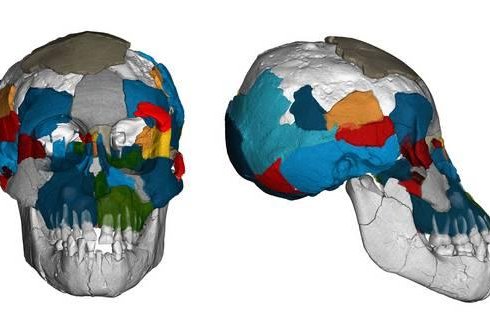New analysis of brain imprints on ancient skull fossils suggests the hominin Australopithecus afarensis had an ape-like brain and prolonged human-like brain growth. Photo by Philipp Gunz/CC
April 1 (UPI) -- The early hominin Australopithecus afarensis -- known to many as Lucy -- walked upright and boasted a brain 20 percent bigger than a chimp's. Some scientists estimate Lucy used simple stone tools.
Lucy, which lived between 3.9 and 2.9 million years ago in Africa, is thought to be a close relative of the Homo genus, which includes modern humans. But new research suggests Australopithecus afarensis had a surprisingly ape-like brain.
Scientists were able to gain new insights into the development and organization of Lucy's brain by studying what are known as endocranial imprints. They published the results of their analysis Wednesday in the journal Science Advances.
"Brains do not fossilize, but as the brain grows and expands before and after birth, the tissues surrounding its outer layer leave an imprint in the bony braincase," Philipp Gunz, biological anthropologist at the Max Planck Institute for Evolutionary Anthropology in Germany, told UPI in an email. "Based on these endocasts we could measure endocranial volume, and infer key aspects of brain organization from impressions of brain convolutions in the skull."
Using CT scans, scientists were able to create detailed virtual models of endocranial imprints inside the braincases of several different Australopithecus afarensis specimens. By counting the dental growth lines -- like tree rings -- scientists were able to precisely date the age of the hominin specimens, including a young child.
"Using high resolution synchrotron scans, we could count the number of daily growth lines in the teeth, and found that the Dikika child died when it was 861 days old," Gunz said.
By comparing the endocasts of infants, adolescents and adults, scientists were able to better understand how the Lucy's brain developed.
When Gunz and his colleagues set out to study the development and organization of Lucy's brain, they were especially interested in locating the elusive endocranial imprint of a part of the brain called the lunate sulcus.
"A key difference between apes and humans involves the organization of the brain's parietal and occipital lobes," Gunz said. "In all ape brains, a well-defined lunate sulcus approximates the anterior boundary of the primary visual cortex of the occipital lobes."
Previously, researchers have hypothesized that Australopithecus afarensis evolved a more human-like brain with a backwards positioning of the lunate sulcus -- a repositioning that might have empowered sophisticated behaviors like tool usage, creative problem solving and vocal communication.
"Unfortunately, the lunate sulcus typically does not reproduce well on endocasts, so there is unresolved controversy about its position in australopiths," Gunz said. "The exceptionally well preserved endocast of the Dikika child has an unambiguous impression of a lunate sulcus in an ape-like position."
Scientists also discovered the signature of an ape-like lunate sulcus in the braincase of an adult australopith.
"Contrary to previous claims, we did not find evidence for brain reorganization in any Australopithecus afarensis endocast that preserves detailed sulcal impressions," Gunz said.
While the organization of Lucy's brain was quite ape-like, its growth during adolescent recalled the development of human brains.
"A comparison of infant and adult endocranial volumes nevertheless indicates more human-like protracted brain growth in Australopithecus afarensis, likely critical for the evolution of a long period of childhood learning in hominins," Gunz said.
Scientists plan to continue studying the endocranial imprints of geologically younger hominin fossils in order to better understand the evolution of brain structures among members of the genus Homo.















